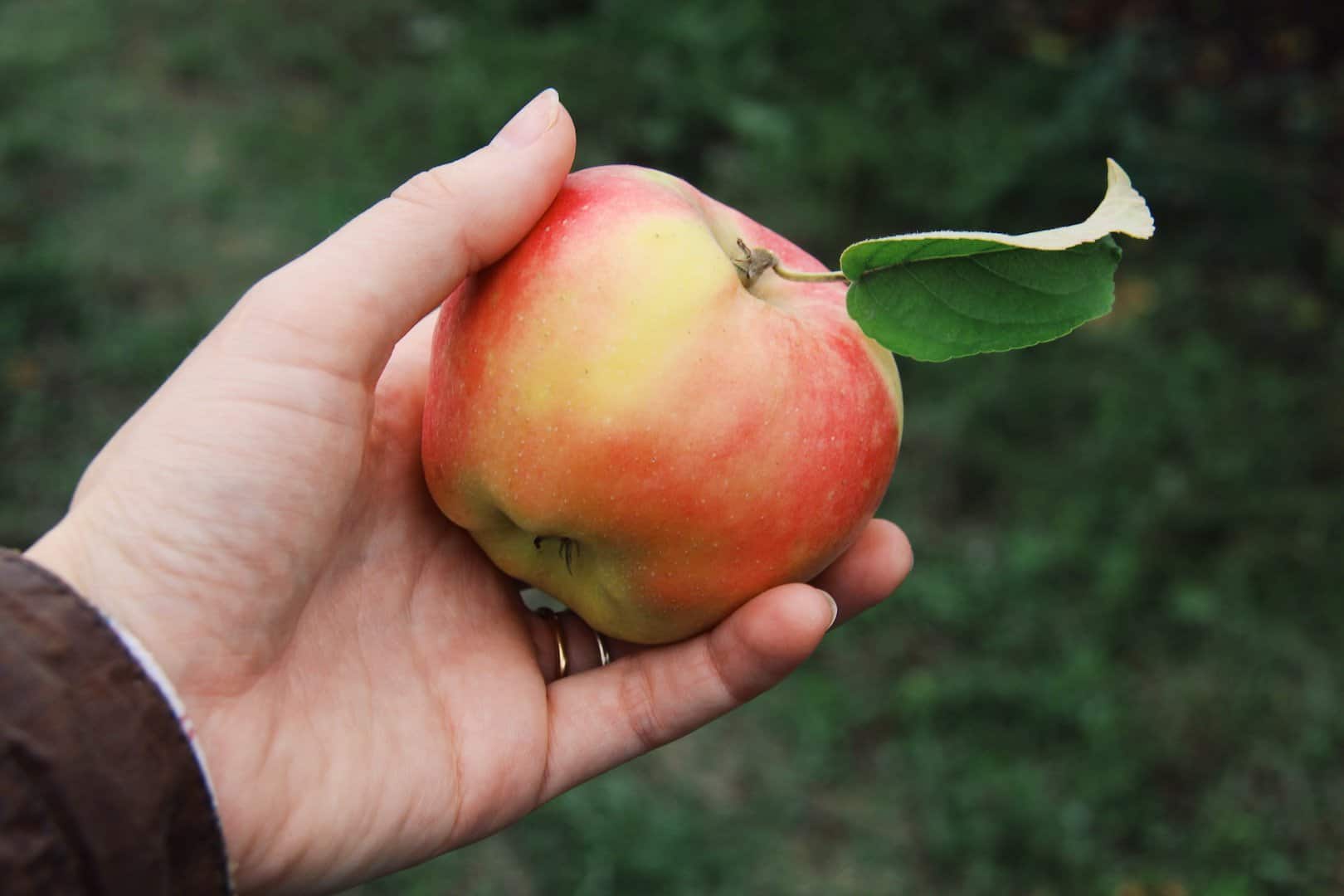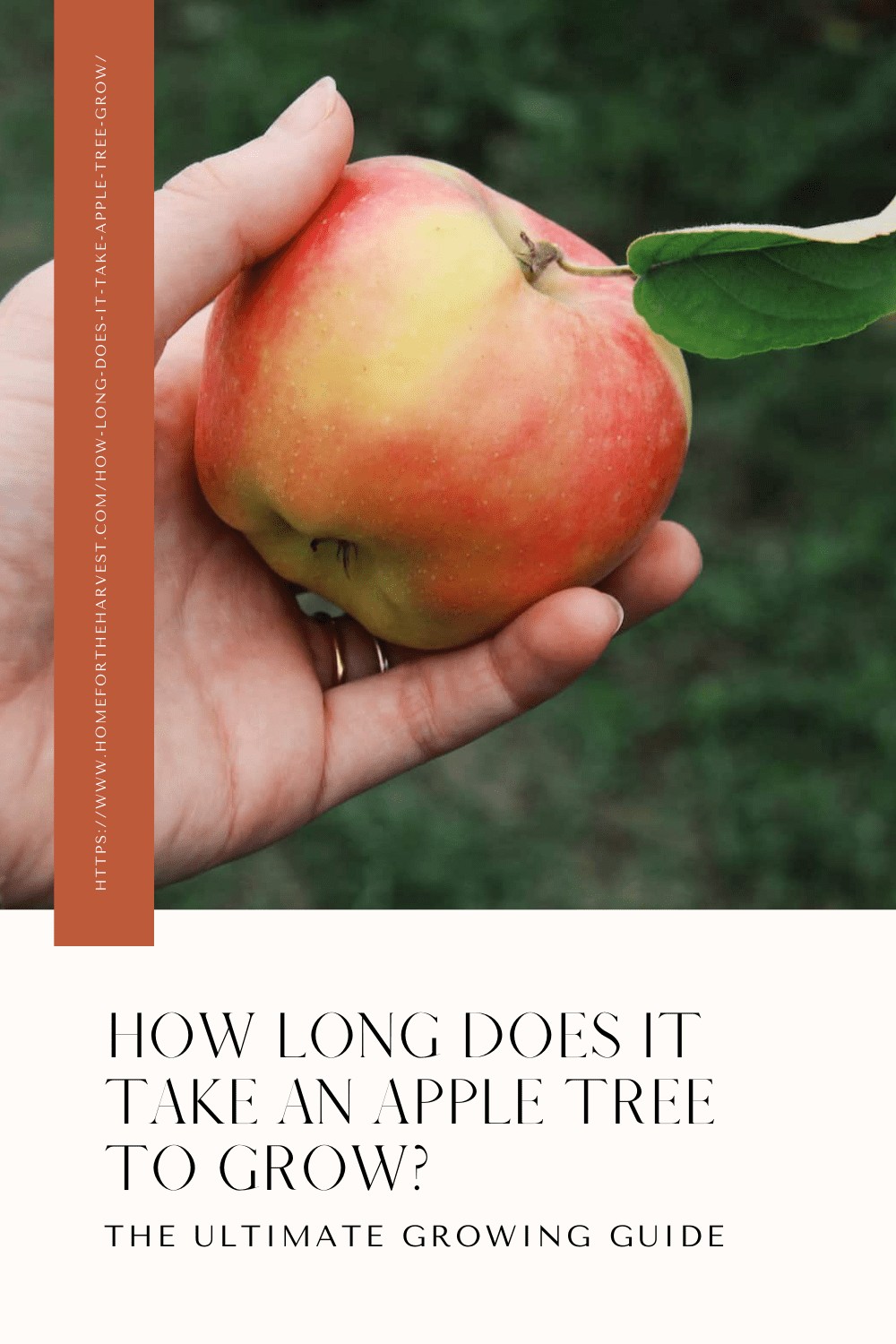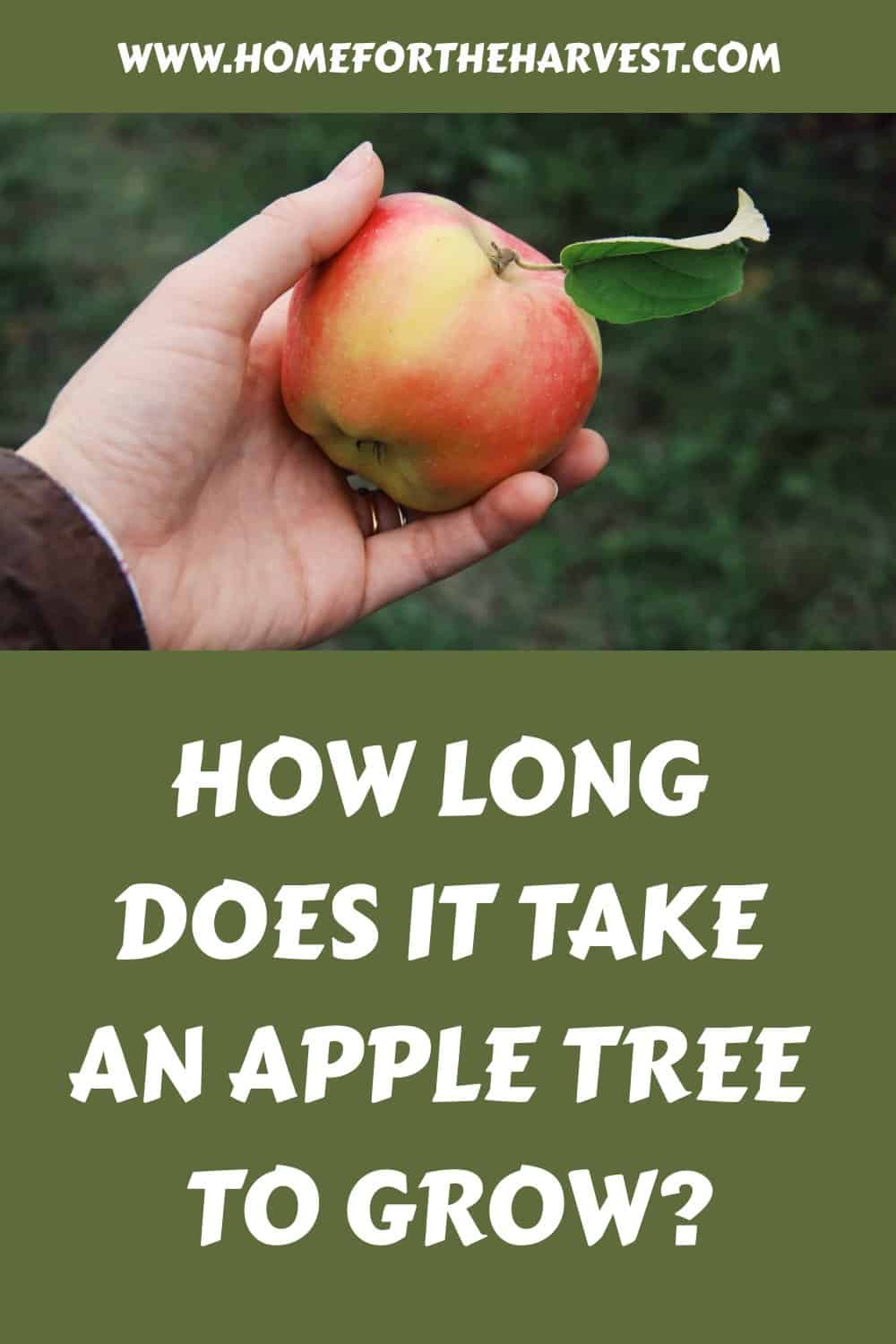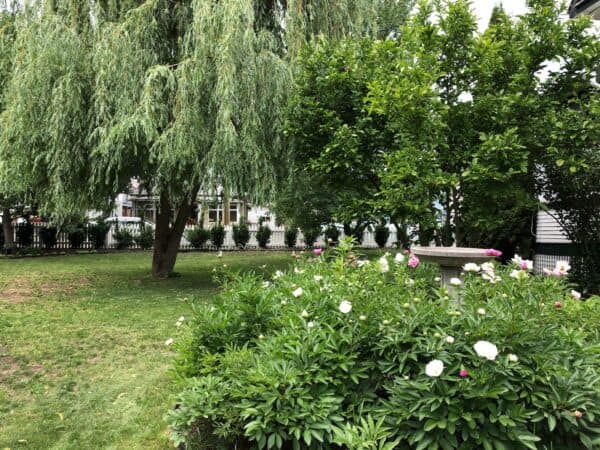If you’re like many enthusiasts I’ve met over the years, you might be wondering, “Just how long does it take for an apple tree to grow and offer its juicy rewards?” I recall the anticipation I felt nearly a decade ago when I planted my first apple trees.
I can assure you that the journey with apple trees, while demanding, is immensely fulfilling. In this post, we’ll delve into the growth stages of an apple tree, factors that influence its development, and crucial care tips to hasten the fruit-bearing phase.
How long does it take an apple tree to grow?
A small apple tree from the nursery will generally start producing a small crop of apples about three years after planting. Apple varieties grafted onto dwarf rootstocks may bear fruit in as little as 1-2 years after purchase if the trees have been grown for several years in a nursery setting prior to sale. Apple trees with standard-height rootstocks may take longer to grow apples – generally from 3 to 5 years. An apple tree grown from seed will take five to twelve years to produce fruit!
The number of years it takes for an apple tree to grow, mature, and bear fruit depends on its rootstock, age when planted, and the cultivar. Here’s all about how long you’ll be waiting to harvest your own yummy apples!
Apple tree growing stages
Most apple trees sold at nurseries are created by grafting a stick from an existing tree onto a separate rootstock. This allows for manual cloning of a variety, which is how we get multiple trees for our favorite varieties, such as Gala, Honeycrisp, and Fuji.
A younger fruit tree is usually grafted using sticks that are about the thickness of a pencil. The trees are typically grown in the nursery for about two years (or more) prior to being sold at a garden center.
Standard apple trees take longer to grow to maturity than dwarf apple trees and semi-dwarf trees. This also means that trees that have been grafted onto dwarf rootstocks typically bear fruit more quickly than those grafted onto standard rootstocks.
If a tree that’s two years of age on a dwarf or semi-dwarf rootstock was sold at a nursery and promptly planted, it may bear a few apples in as soon as three years (for a total age of about five years).
More established apple trees may only take 1-2 years to bear fruit after purchase. Ultimately, the rootstock plays a major role in determining the tree’s ultimate size and how long it will take to bear fruit.
Most varieties of apple trees grow and produce well in plant hardiness zones 4-8. Apple fruit trees tend to reach maturity faster when the climate zones aren’t overly cold (like in chilly zone 4), but they need adequate winter chilling hours to produce fruit (which can be tricky in zone 8 if the winter is mild).
If you don’t know your local growing zone, look it up on the USDA Climate Hardiness Map by zip code or name of your town. These trees also grow best when grown in well-drained soil and in a spot with good air circulation.
While not common in commerce, an apple tree can be grown from seed. This is how wild apple trees grow and how scientists breed new varieties. Apple trees on their own roots (not a grafted rootstock) are usually much larger in size than grafted orchard trees.
An apple tree grown from seed can be expected to take 6-10 years to grow to a mature tree and reach the point where it can reliably produce ripe fruits.
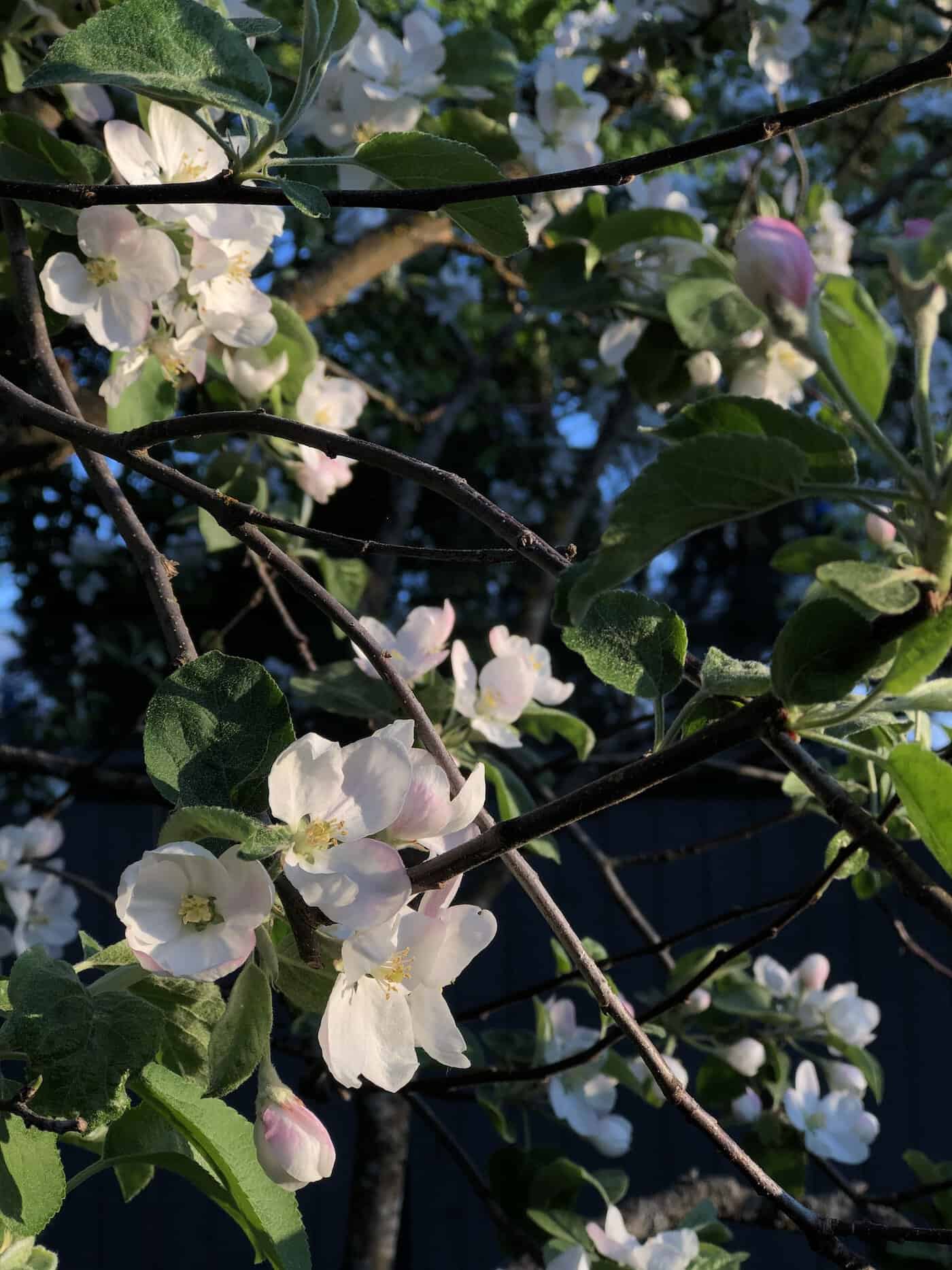
Apple fruit formation
Apples form on apple tree branches of mature trees when blossoms are successfully pollinated. Each blossom has the potential to become an apple. Apple trees blossom each spring on branches that have overwintered on the tree.
While different apple varieties bloom at slightly different times, most bloom in mid-spring. Apple trees tend to bloom in May in apple-growing regions (around the time that tulips bloom).
Similar to other fruit trees, apple trees are most commonly pollinated by bees. There are a few varieties of apples that are self-fertile and can be pollinated with their own pollen, but most varieties of apple trees require a different apple variety growing nearby to produce fruit.
Pollinating insects move the pollen from one tree’s blossoms to a different tree’s blossoms to pollinate each blossom. This is why apple trees are commonly planted in pairs, where the trees are different varieties that tend to bloom simultaneously.
Apple orchards interplant apple varieties for better pollination. Nearby crabapple trees can also work as pollinator partners.
Harvesting apples from apple trees
Each apple tree produces fruit only once per year: each autumn. Fresh organic apples are abundant in the fall. Apple harvest time in North America is between August and October.
Apples grown in the Southern Hemisphere tend to ripen during February-March. Because few apples can be stored for 12 months, apples are generally shipped around the world to ensure year-round availability at the grocery store.
Apple trees are truly gorgeous throughout the year. From the display of blossoms in the spring to the harvest of fruit in the fall, the apple tree is truly a showstopper in the yard. And apple trees produce fruit best when they have some other apple trees of a different type nearby! Here are some lovely different types of apples to grow.
Apples can be harvested off the branch by gently turning each apple upside down so that the bottom is facing up to the sky. There is no need to twist or pull on the apple. Ripe apples will come off the tree gently when inverted. Apples are sweetest when left on the tree to ripen.
“Grafting is common because it can take five to 12 years until a tree grown from seed is ready to produce fruit – and even then, the chances of the “seedling” tree producing tasty fruit is minimal, due to genetic diversity.”
Growing Urban Orchards: How to Care for Fruit Trees in the City and Beyond, by Susan Poizner
Planting your own apple trees
Have you noticed apple trees in neighbors’ yards, orchards, or at local nurseries? If so, you can consider planting your own mini-orchard. Growing your own organic apples is a bit of an exercise in patience, but the effort is rewarded sweetly each fall.
If you do decide to plant your own apple trees, you’re in luck! Spring is a good time, as the stock in the garden centers is usually the best. But keep in mind that fall is the perfect time to plant new trees. Not only are trees generally reasonably priced in the fall, but they also are headed into winter dormancy. It’s a great time to plant them. After they bear fruit all summer, fruit trees get a break in the fall and winter seasons.
Planting trees in the fall will ensure they don’t have to endure the stresses of the hot sun, parched soil, or the burden of producing fruit. Newly planted fruit trees can cozy up in their new homes for the winter. Your new trees will be right at home by the time they blossom in the spring.
That said, it’s also completely possible to plant an apple tree in the spring. Just take extra care to ensure they are very well watered for the first year or two as the roots become established in the soil.
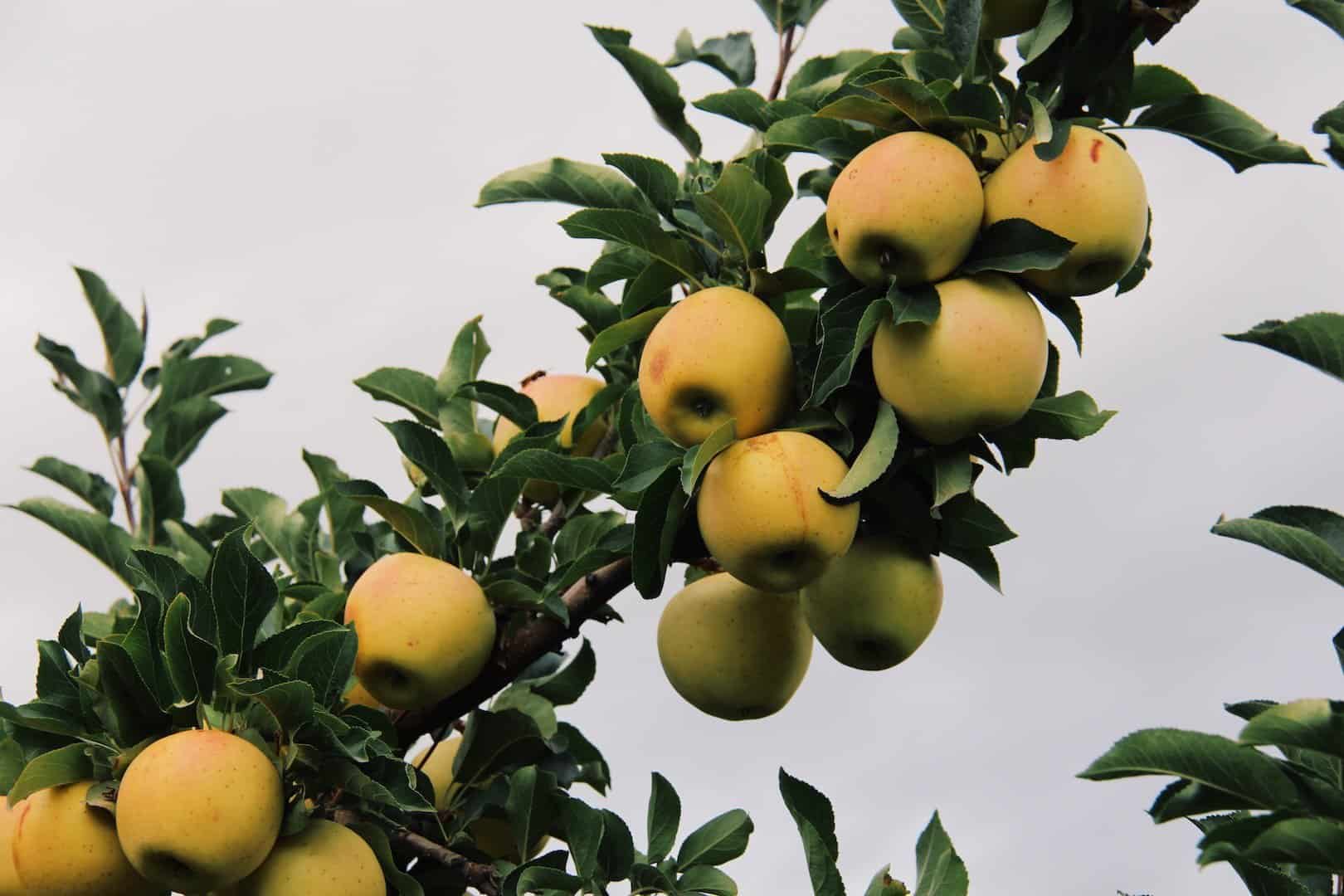
Planning your orchard and purchasing apple trees
If you’d like to start growing organic apples, first take a look at your property to decide the best location for the trees. Pick an area of your yard that gets ample sunlight, preferably in the morning. This will ensure the production of good fruit.
You’ll also want to make sure this area is accessible for future apple picking. Keep in mind that you’ll need at least two apple fruit trees of two different apple varieties to ensure cross-pollination. Take some measurements to bring along to the nursery with you.
Once you’ve planned your planting area, head down to your local independent nursery for some trees. Talk over the available varieties with the nursery staff.
Pick two varieties that blossom at the same time to ensure good pollination. If local availability is limited, it’s also possible to buy apple trees online.
Common, conventionally-grown trees are available throughout the year from larger retailers, while more unique varieties (Ambrosia, Pink Lady, Jonathan) may only be available in the shoulder seasons.
If you can only fit one apple tree in your yard, you may be able to find a self-pollinating type. Alternatively, you might get away with a single tree if your neighbors also have trees. If the trees are compatible and bloom at the same time, a tree within about 100 feet may be able to provide adequate (if not ideal) pollination.
You may also consider planting dwarf or semi-dwarf varieties. These smaller trees make apple harvest easier (especially for children).
Discuss your individual needs with the staff at your local independent nursery. They will know the specifics of your region, including the best varieties and other geographically specific tips.
When immature, a fruit tree can only be transplanted reliably from the nursery to your garden or orchard. In fact, the younger the tree, the better – a 1-year ‘maiden’ tree will invariably establish quicker and grow away better in the spring than an older tree.
Even if mature fruit trees were available, they would almost certainly not fruit straight after planting, and without specialist planting and care in the first year after planting might not survive at all.
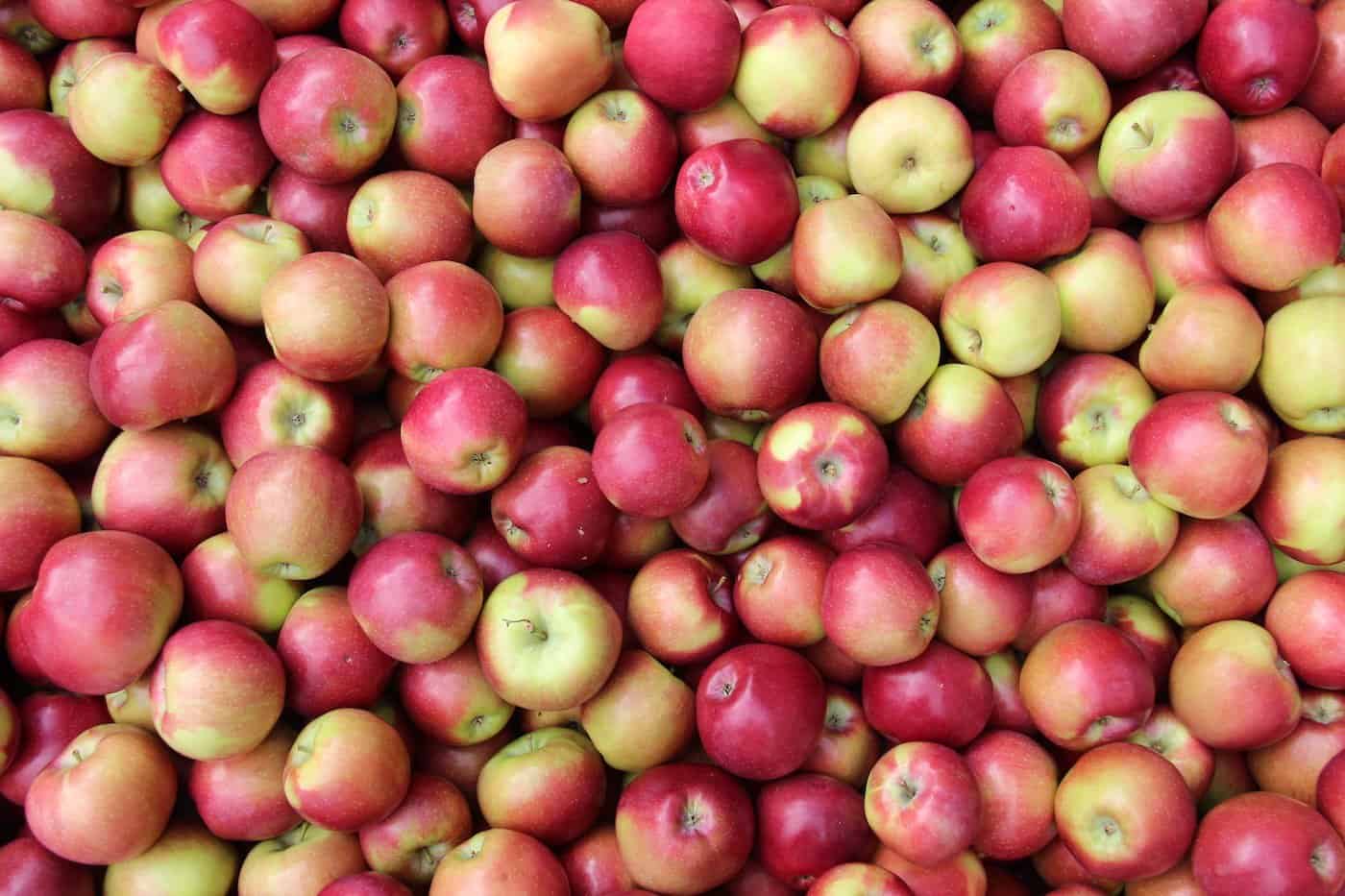
Growing apple trees from seed
If you’re not into buying trees, growing an apple tree from seed is possible. Growing an apple tree from seed does not always produce good fruit. In fact, the apples produced by a tree grown from seed will not be the same as the apple from which the seeds were collected.
If you do decide to grow your own trees from seed, start with seeds you’ve collected from local organic apples that you thought were delicious. But you really have no idea what the apples of the offspring tree will taste like. It’s a bit of a lottery – and you’ve got to wait almost a decade to see how it goes. They might be good for making juice, for making apple sauce, or even for pies. Or not.
Growing organic apple trees from seed isn’t exactly standard practice. All the apple trees you see in nurseries and orchards are likely grafted. If you are a little adventurous and patient, you can certainly try growing your apple tree from seed.
How to plant apple trees
If you decide to buy grafted trees rather than growing from seed, as I did, place the new trees in their containers close to their future homes on your property. Rotate the container around to find the most suitable orientation of the branches.
Once you’re confident about the future homes for the trees, dig a hole for each tree. If you’re not sure about the location, you may want to observe the environment in your yard, try out a few areas, and find the best location for your trees.
For dwarf varieties, plant the trees between 15 ft and 50 ft apart. Each hole should be quite wide (perhaps twice the size of the container in which the tree is delivered). Hole depth, however, should not be deeper than the tree’s container.
Resist the urge to “improve” the hole by adding fertilizer. This will only encourage the tree to grow exactly when it needs to be dormant for winter.
Place each tree in the hole so that the soil in the container is at the same level as the surrounding ground. Backfill the hole with the existing soil and lightly tamp it down. Do not compact the soil excessively.
How to grow organic apples
Give the tree a thorough watering after planting. If you wish to feed the tree, a light mulch of compost can be applied on top of the soil after you’ve finished planting the tree. Ensure that no soil or mulch is touching the tree trunk. Soil and mulch should never touch the bark of any tree, as it invites moisture, bacteria, and rot. This may prevent the tree from producing good fruit.
If you mulch the tree with shredded fall leaves for the winter, keep the same rule in mind. Mulch, of any kind, should never touch the bark of a tree.
Don’t try to do too much to the tree before it goes dormant for winter. Fall is not the time to start pruning a newly planted apple tree. Wait until winter or early spring to do any pruning (although young trees may not require it yet).
Fertilizer is not recommended in Autumn. Also, beware that if you use synthetic chemical fertilizer on your apple tree, it won’t be organic anymore! Top dress the soil with a bit of compost in the fall if you must, but otherwise, just make sure it has enough water and leave it to its own devices. The best time to fertilize fruit trees is in the spring.
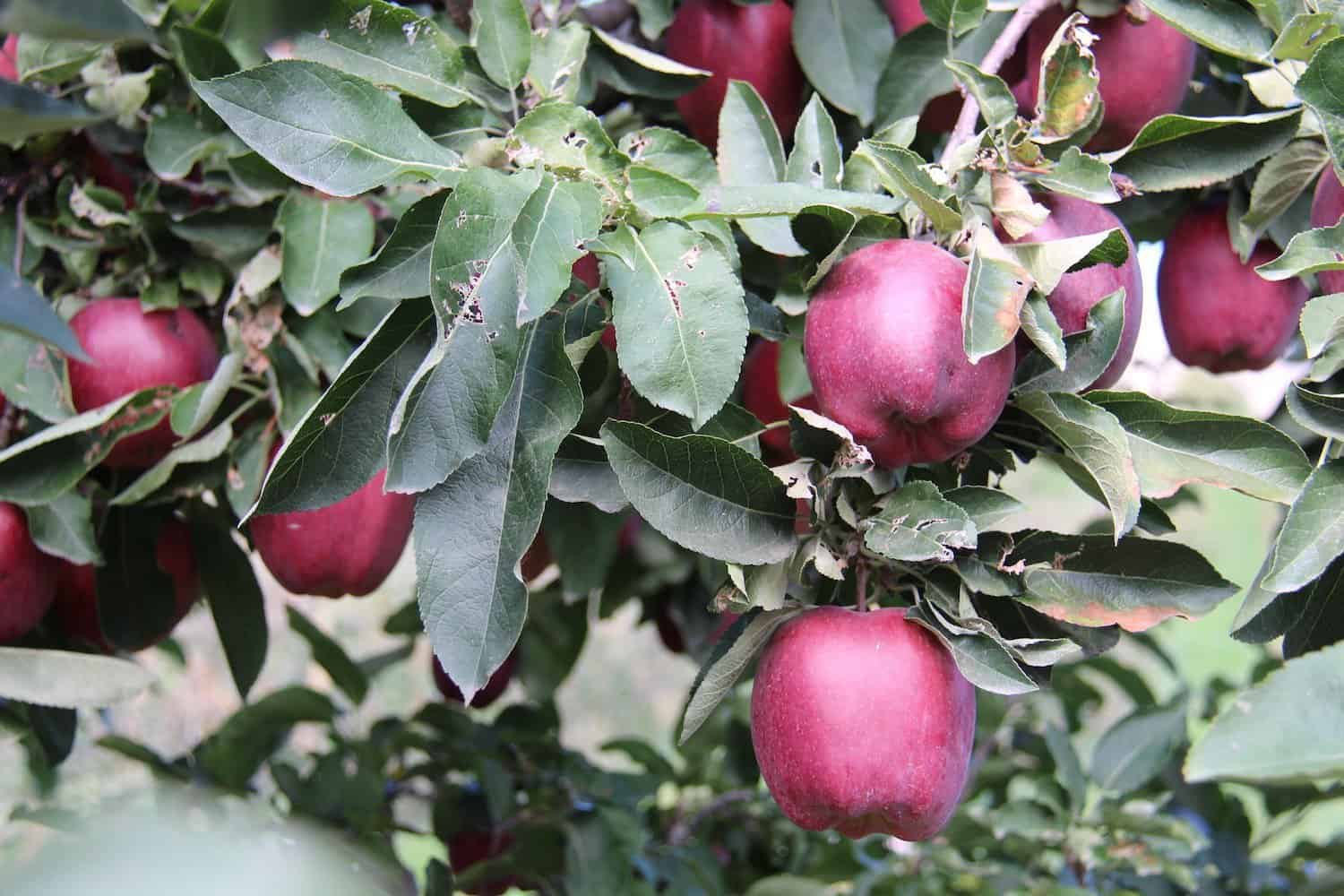
General maintenance for growing organic apples
In the winter or early spring, you can give the tree a light pruning if necessary. Remove any cross-branches (branches that go in odd directions) or dead/damaged/diseased parts of the tree. As you are working with a young tree that has been recently transplanted, be gentle with the pruning. Don’t remove too much of the tree in its first year.
Your goal is only to improve airflow around individual branches by reducing branch crowding. You want the sun’s rays to reach the center of the tree and air to circulate around each branch. This will help the tree to bear fruit properly.
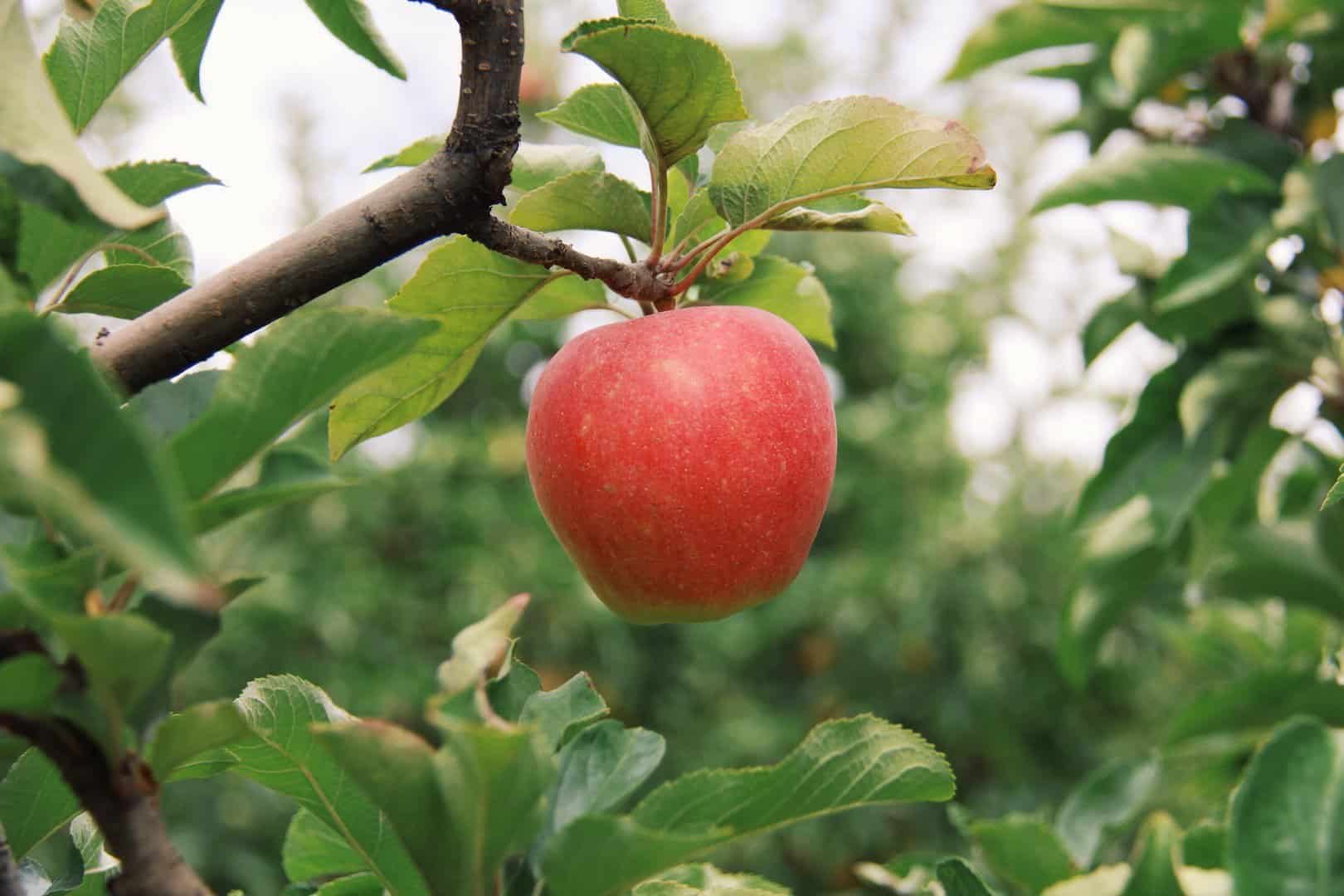
If you are new to pruning, I recommend borrowing a copy of The Pruning Book, by Lee Reich, from your local library or friendly fruit enthusiast. Lee is a fruit-growing guru who is known for his scientifically based yet practical methods of instruction. His book, Grow Fruit Naturally, is also an excellent resource if pests invade your trees. There are several methods of chemical-free, natural pest control suited to growing organic apples.


